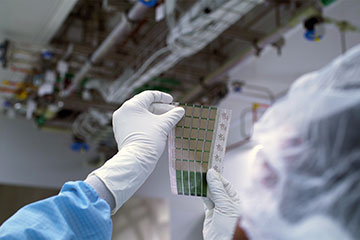
A team of engineers from the Massachusetts Institute of Technology (MIT) have developed a scalable fabrication technique to produce ultrathin, lightweight organic solar cells that can be attached to nearly any surface for ubiquitous power generation. [Image: M. Gonick, MIT]
A new fabrication technique promises thin, flexible organic photovoltaics that could be laminated onto different surfaces for additive power without excessive weight or bulk (Small Methods, doi: 10.1002/smtd.202200940). The technique includes printing the solar-cell electrodes from semiconducting inks and backing them with a durable, lightweight fabric. The resulting sheet of solar cells can be attached to nearly any surface and provide energy wherever it is needed.
“While it might appear simpler to just print the solar cells directly on the fabric, this would limit the selection of possible fabrics or other receiving surfaces to the ones that are chemically and thermally compatible with all the processing steps needed to make the devices,” said research team member Mayuran Saravanapavanantham, Massachusetts Institute of Technology (MIT), USA. “Our approach decouples the solar cell manufacturing from its final integration.”
In prototype demonstrations of the fabric-backed printed solar cells, the MIT engineers observed the generation of 370 watts of power per kilogram—about 18 times more power per kilogram than conventional solar cells.
From fragile to durable
Existing solar cells are often coated with glass and mounted in a rigid frame to improve their durability. This structural reinforcement protects the delicate photovoltaics, but it also limits where they can be installed. The MIT team aimed to create solar cells that were not only durable and flexible—in design and application—but also efficient.
The team’s proposed solution is a scalable printing technique that uses organic electronic inks for high-performance thin-film photovoltaics. Using a slot-die coater, the researchers apply tin-oxide nanoparticle “ink” onto silver nanowire solar-cell structures mounted on a polyethylene terephthalate substrate.
Once cured, the solar cells are peeled away from the plastic substrate. The super-thin freestanding solar cells are then glued to a lightweight and high-strength composite fabric called Dyneema, creating a 50 µm-thick organic photovoltaic system.
When backed with Dyneema, the solar cells have a specific power of 370 W/kg. In durability tests, the researchers found that the modules maintained 90% of their original performance after rolling and unrolling the sheets 500 times.
Limitations and future plans
While the new high-performance ultra-thin organic photovoltaic sheets are extremely durable, the researchers’ carbon-based components could be damaged when exposed to wind, rain and sun from outdoor weather conditions. The researchers are now working on a low-profile packaging solution that would protect the organic elements without compromising energy generation.

